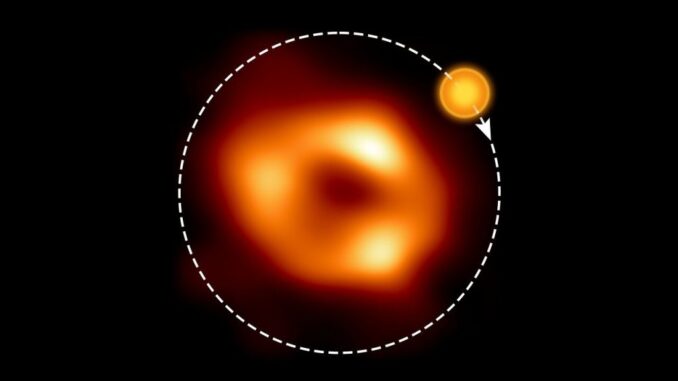
By Mark Waghorn
A huge gas bubble is swirling around the Milky Way’s supermassive black hole at almost a third of the speed of light, reveals a new study. As big as the planet Mercury, it completes a full circle in just 70 minutes – over 200 million miles an hour.
Astronomers say the mysterious region at the heart of our galaxy is about ten billion times bigger than the sun.
Lead author Dr. Maciek Wielgus, of the Max Planck Institute for Radio Astronomy in Germany, said: “We think we’re looking at a hot bubble of gas zipping around Sagittarius A* on an orbit similar in size to that of the planet Mercury – but making a full loop in just around 70 minutes.”
He added: “This requires a mind-blowing velocity of about 30 percent of the speed of light.”
An international team spotted the ‘hot spot’ using the ALMA (Atacama Large Millimeter/submillimeter Array) radio telescope in the Chilean Andes.

It sheds fresh light on the enigmatic and dynamic environment. Supermassive black holes are incredibly dense areas in the center of galaxies.
They act as intense sources of gravity which hoover up dust and gas around them.
Sagittarius A* is only 26,000 light-years away from Earth.
It’s one of the very few black holes in the universe where we can actually witness the flow of matter nearby.
Because the area absorbs all surrounding light, it is incredibly difficult to see, and scientists have spent decades searching for hints of black hole activity.
The observations were made by the European Southern Observatory (ESO) during a campaign by the Event Horizon Telescope (EHT) Collaboration to image black holes.
In April 2017, eight existing radio telescopes were linked worldwide, resulting in the first-ever image of Sagittarius A*.
Dr. Wielgus and colleagues used ALMA data recorded simultaneously with the EHT observations of Sagittarius A*.
There were more clues to the nature of the black hole hidden in the ALMA-only measurements.
Serendipitously, some were done shortly after a burst or flare of X-ray energy was emitted from the center of the Milky Way and detected by NASA’s Chandra Space Telescope.
These kinds of flares, previously observed with X-ray and infrared telescopes, are thought to be associated with ‘hot spots’ – gas bubbles that orbit very fast and close to the black hole.
Dr. Wielgus said, “What is really new and interesting is that such flares were so far only clearly present in X-ray and infrared observations of Sagittarius A*.”
“Here we see for the first time a very strong indication that orbiting hot spots are also present in radio observations.”
Less than 1 percent of the material initially within the black hole’s gravitational influence reaches the event horizon, or point of no return, because much of it is ejected.
Consequently, the X-ray emission from the material is remarkably faint, like that of most of the giant black holes in galaxies in the nearby universe.
Co-author Jesse Vos, a Ph.D. student at Radboud University, the Netherlands, said: “Perhaps these hot spots detected at infrared wavelengths are a manifestation of the same physical phenomenon.”
“As infrared-emitting hot spots cool down, they become visible at longer wavelengths, like the ones observed by ALMA and the EHT.”
The flares were thought to originate from magnetic interactions in the extremely hot gas orbiting very close to the black hole. The findings support this idea.
Co-author Dr. Monika Moscibrodzka, also from Radboud, said: “Now we find strong evidence for a magnetic origin of these flares, and our observations give us a clue about the geometry of the process.”
“The new data is extremely helpful for building a theoretical interpretation of these events.”
ALMA allows astronomers to study polarized radio emissions from Sagittarius A*, which can be used to unveil the black hole’s magnetic field.
The data, combined with theoretical models, sheds light on the formation of the hot spot and the environment it is embedded in – including the magnetic field.
Stronger constraints on the shape of previous observations help uncover the nature of our black hole – and its surroundings.
Scans by the GRAVITY instrument at ESO’s Very Large Telescope (VLT), which observes in the infrared, and ALMA suggest the flare originates in a clump of gas.
It swirls around the black hole at about 30 percent of the speed of light in a clockwise direction in the sky – with the orbit of the hot spot being nearly face-on.
Co-author Dr. Ivan Marti-Vidal, of the University of Valencia, said: “In future we should be able to track hot spots across frequencies using coordinated multiwavelength observations with both GRAVITY and ALMA.”
“The success of such an endeavor would be a true milestone for our understanding of the physics of flares in the Galactic Center.”
The team is also hoping to be able to directly observe the orbiting gas clumps with the EHT, to probe ever closer to the black hole and learn more about it. Dr. Wielgus said, “Hopefully, one day, we will be comfortable saying we ‘know’ what is going on in Sagittarius A*.”
The study is in the journal Astronomy & Astrophysics.
How black holes form is still poorly understood. Astronomers believe it happens when a large cloud of gas up to 100,000 times bigger than the sun collapses.

Many of these ‘seeds’ then merge to form much larger supermassive black holes, which are found at the center of every known massive galaxy.
Alternatively, a supermassive black hole seed could come from a giant star, about 100 times the sun’s mass, that ultimately forms into a black hole after it runs out of fuel and collapses. When these giant stars die, they also go ‘supernova’, a huge explosion that expels matter from the outer layers of the star into deep space.
Produced in association with SWNS Talker.
Recommended from our partners
The post Huge Gas Bubble Swirling Around Milky Way’s Supermassive Black Hole appeared first on Zenger News.
